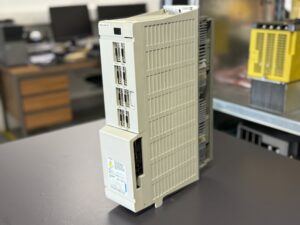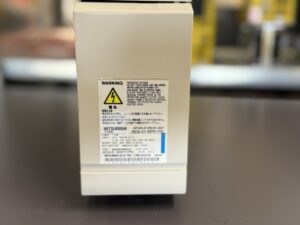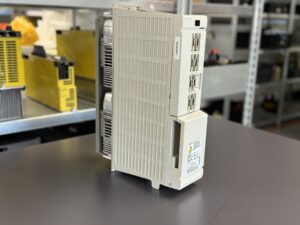18.05.2025 by Viktor Siebert
Mitsubishi MDS-C1-SPH-110 Spindle Drive Unit Repair Story
Background
The Mitsubishi MDS-C1-SPH-110 Spindle Drive Unit came to us already pre-repaired. The device had previously been with another repair service provider for nearly three weeks. It returned to the customer and only functioned for two days. When we received and inspected the device, we were also quite astonished. We have seen many things, but this repair was truly beyond comprehension.
The Initial Repair Attempt
Our customer reported finding a very affordable offer online. He quickly received a convincing callback from the provider, promising to repair the device in the shortest possible time. However, three days later, the customer received a quote that was more than 50% higher than originally promised: instead of 700 Euros, the offer was 1500 Euros. Even cleaning the device was listed separately. Additionally, the company charged 200 Euros for preparing the estimate in case of non-repair, something never mentioned previously.
The customer, grinding his teeth and lacking alternatives, accepted the offer, saving at least 300 Euros but compromising on the device’s appearance. After three weeks, he finally received the device, which was covered in dirt and oil. Nevertheless, he accepted it as it was cheaper.
Problems Post-Repair
After installation, the customer noticed that the device operated unusually loud but initially functioned. Just two days later, the device permanently failed due to an overload (Alarm AL32 – overload in the main power circuit). The customer had an external service provider check the wiring and motor and even temporarily replaced the spindle motor. Upon contacting the initial repair provider again, warranty claims were dismissed, and the provider demanded that both motor and drive be sent back for further inspection. Finally, the customer had enough and reached out to us.
Our Findings
Our technicians discovered the following severe issues:
- Electrolytic capacitors on the power board were incorrectly replaced: instead of the required 220 µF/50 V capacitors, 120 µF/50 V capacitors were used.
- Incorrect and used current measurement modules with incorrect ratings were installed.
- Used and excessively loud fans were installed.
- An incorrect transistor module rated at 100 A instead of the required 150 A was used. Although labeled “150 A,” it was a Chinese fake with re-labeled markings.
- The device had not been cleaned. It was extremely dirty, with oil and grime dripping from the heat sink.
Despite these major flaws, the previous technician had somehow managed to get the device briefly operational. However, it was obviously not a sustainable solution.
Our Professional Repair
We corrected all identified faults. The incorrect transistor module and presumably also the current measurement modules were the main culprits causing the issue this time. After our repair, the device was reinstalled a few weeks ago. Since then, it has been running smoothly, quietly, and reliably. The customer from France, who visited us personally, was extremely relieved and happy that this lengthy odyssey had finally reached a positive conclusion.
Conclusion and Recommendations
We regularly share cases like these and consistently encourage customers to opt for reputable and honest electronics repair alternatives. Always inquire thoroughly about the repair offer:
- What exactly will be repaired?
- How will the repair be performed?
- Are replacement parts genuinely available?
- Is there an option for replacement if the device is irreparable?
- What is the cost of preparing the estimate? Paying for it is acceptable, but customers should be informed in advance.
- Will the device be tested after the repair, and how?
Only through detailed information and trustworthy providers will you be satisfied long-term and retain confidence that reliable and honest companies still exist.




To mentioned Mitsubishi Drive: Mitsubishi MDS-C1-SPH-110 Spindle Drive Unit
More details about our Mitsubishi repair services can be found here:
Mitsubishi drive Repair by Industrypart
📞 Feel free to contact us with any questions about your Yaskawa drive technology.
Our expert team is happy to help!
Device Description and Technical Specifications
| Feature | Value |
|---|
| Model | MDS-C1-SPH-110 |
| Product Type | Spindle Drive Unit |
| Power | 11 kW |
| Input | 41 A, DC 270–311 V |
| Control Power | 0.2 A, Single-phase, 200–230 V, 50/60 Hz |
| Output | 37 A, 3-phase, 200 V, 0–833 Hz |
| Cooling | Air cooling |
| Manual Reference | BNP-C3000 |
| Protection Standard | DIN VDE0160 |
| Hardware Version | D |
| Weight | Approx. 11 kg (typical) |
Operational Environment and Compatible Devices
| Component | Description |
|---|
| CNC Controller | Compatible with Mitsubishi CNC controllers (e.g., MELDAS M60/M64/M65 series) |
| Power Supply Unit | Mitsubishi MDS-C1-CV series |
| Servo Drives | Mitsubishi MDS-series servo drives |
| Spindle Motors | Mitsubishi SJ-series spindle motors (e.g., SJ-11, SJ-V11) |
| Operating Temperature | 0–55 °C (optimal performance up to 45 °C) |
| Humidity | 10–90 % (non-condensing) |
| Mounting | Cabinet mounting with sufficient ventilation |
| Protection Class | IP20 (mounting inside an enclosure required) |
Alarm Codes and Troubleshooting (Solutions)
| Alarm Code | Description | Possible Causes | Recommended Actions |
|---|
| AL.12 | Memory Error (SRAM/FROM checksum) | Internal memory error or disturbances | Restart the unit; replace if error persists |
| AL.16 | Pole-position detection error | Encoder or wiring problem | Inspect feedback cables and encoder, replace if necessary |
| AL.18 | Communication error with position sensor | Faulty wiring or defective position sensor | Inspect wiring and sensor, replace defective parts |
| AL.21 | No signal from position sensor | Faulty or disconnected position sensor | Check and repair sensor and connections |
| AL.32 | Overcurrent detected in power module | Short-circuit in wiring, motor, or drive unit | Inspect wiring and motor, replace faulty components |